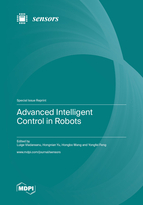Advanced Intelligent Control in Robots
A special issue of Sensors (ISSN 1424-8220). This special issue belongs to the section "Sensors and Robotics".
Deadline for manuscript submissions: closed (31 December 2022) | Viewed by 49221
Special Issue Editors
Interests: robot control; intelligent control; artificial intelligence; intelligent agents; intelligent sensor systems; advanced intelligent control methods and techniques; intelligent decision support systems; versatile intelligent portable platforms; human–robot (H2R) interaction systems; machine-to-machine (M2M) interfaces; prediction; machine learning; IoT technologies; cyberphysical systems; IT Industry 4.0 concept; industrial systems in the digital age; intelligent sensors applied to rescue robots; firefighting robots; rehabilitation robots; robot-assisted surgery; domestic robots
Special Issues, Collections and Topics in MDPI journals
Interests: robotics and intelligent control; applied artificial intelligence; data analysis; data sciences with applications in digital healthcare and manufacturing systems; applications of emerging technology, such as RFID, wireless technology, etc. into healthcare and manufacturing systems
Special Issues, Collections and Topics in MDPI journals
Interests: upper and lower limb rehabilitation robot; finger rehabilitation robot; vascular intervention surgical robot; assisting robots for the disabled and the elderly; walking robots with a parallel leg mechanism; nursing robots for transporting patients; intelligent robot control
Interests: advanced intelligent control; robot control; rehabilitation robot; service robot for the elderly; intelligent sensor systems; intelligent decision support systems; adaptive sensor networks; virtual and augmented reality; intelligent remote control and communication; visual recognition
Special Issue Information
Dear Colleagues,
This SI aims to present and communicate new trends in the design, control, and applications of real-time intelligent sensor system control using advanced intelligent control methods and techniques in robotics. Thus, we welcome the submission of original research papers and review papers that report recent advancements in intelligent control using intelligent sensors. In particular, we encourage submissions related to the use of innovative multisensor fusion techniques integrated on robots that combine computer vision, virtual and augmented reality (VR&AR), intelligent communication (e.g., remote control), adaptive sensor networks, and intelligent decision support systems (IDSS, e.g., remote sensing) and their integration with DSS, such as GA-based DSS, fuzzy set DSS, rough-set-based DSS, intelligent agent-assisted DSS, process mining integration to decision support, adaptive DSS, computer-vision-based DSS, sensory and robotic DSS, human–robot (H2R) interaction systems, and machine-to-machine (M2M) interfaces, as an extension of the previously published Special Issue: https://www.mdpi.com/journal/sensors/special_issues/advanced_intelligent_control.
We also invite authors to submit papers related to the utilization of new technologies with advanced intelligent control that apply complex robotic systems, such as enhanced IoT technologies and applications in the 5G densification era, bio-inspired techniques for future manufacturing enterprise control, a cyberphysical system approach to the cognitive enterprise, development of the IT Industry 4.0 concept, industrial systems in the digital age, cloud computing, robotics and automation with applications such as human aid mechatronics, military applications, rescue robots, firefighting robots, rehabilitation robots, robot-assisted surgery, and domestic robots.
Prof. Dr. Luige Vladareanu
Prof. Dr. Hongnian Yu
Prof. Dr. Hongbo Wang
Dr. Yongfei Feng
Guest Editors
Manuscript Submission Information
Manuscripts should be submitted online at www.mdpi.com by registering and logging in to this website. Once you are registered, click here to go to the submission form. Manuscripts can be submitted until the deadline. All submissions that pass pre-check are peer-reviewed. Accepted papers will be published continuously in the journal (as soon as accepted) and will be listed together on the special issue website. Research articles, review articles as well as short communications are invited. For planned papers, a title and short abstract (about 100 words) can be sent to the Editorial Office for announcement on this website.
Submitted manuscripts should not have been published previously, nor be under consideration for publication elsewhere (except conference proceedings papers). All manuscripts are thoroughly refereed through a single-blind peer-review process. A guide for authors and other relevant information for submission of manuscripts is available on the Instructions for Authors page. Sensors is an international peer-reviewed open access semimonthly journal published by MDPI.
Please visit the Instructions for Authors page before submitting a manuscript. The Article Processing Charge (APC) for publication in this open access journal is 2600 CHF (Swiss Francs). Submitted papers should be well formatted and use good English. Authors may use MDPI's English editing service prior to publication or during author revisions.
Keywords
- Advanced intelligent control
- Robot control
- Rehabilitation
- Mobile robots
- Intelligent sensor systems
- Intelligent decision support systems
- New technologies
- Adaptive sensor networks
- Virtual and augmented reality
- Intelligent remote control and communication










